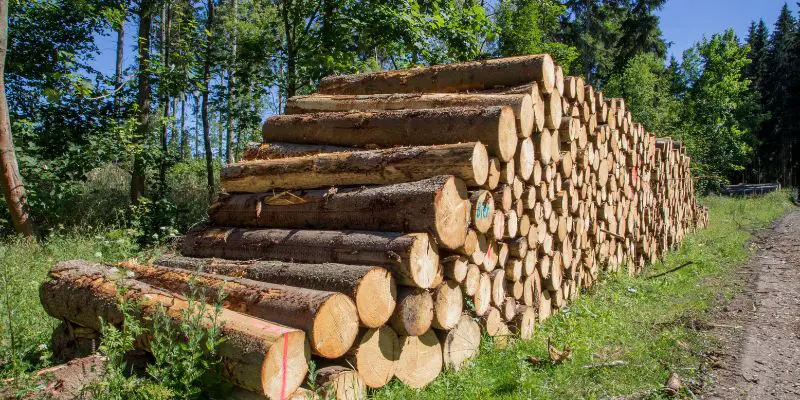Wood typically takes around six to twelve months to dry, depending on factors such as the type of wood, thickness, and environmental conditions. The drying process allows the wood to reach a moisture content level suitable for use without compromising its stability or causing issues such as warping or cracking.
Properly seasoned wood is essential for construction, carpentry, and woodworking projects as it ensures the longevity and quality of the final product. Harvested wood must be allowed sufficient time to dry naturally, either by air-drying or kiln-drying before it can be used for various purposes.
Understanding the drying time for wood is crucial for those working with timber to ensure optimal results in their projects.
Understanding Wood Moisture Content
Wood moisture content is crucial to consider when determining how long it takes for wood to dry. Various factors affect the drying time, including the type of wood, thickness, and environmental conditions. Monitoring moisture levels is essential for preventing warping, cracking, and other issues.
What is Wood Moisture Content?
Wood moisture content refers to the amount of water or moisture present within the structure of wood. It is typically measured as a percentage of the weight of the water in the wood compared to the weight of the wood fibers. The moisture content of wood can vary depending on various factors including the species of wood, the environmental conditions, and the processing methods applied.
Why is Wood Moisture Content Important?
Wood moisture content is an essential factor to consider when working with wood, whether it be for construction, woodworking, or wood flooring. Understanding the moisture content of wood is crucial for several reasons:
1. Dimensional Stability: The moisture content directly affects the dimensional stability of wood. When wood gains or loses moisture, it expands or contracts, causing dimensional changes. This can lead to warping, cracking, or even structural instability over time. By knowing the moisture content of wood, proper measures can be taken to prevent or minimize these issues.
2. Workability: Wood with a high moisture content can be challenging to work with, especially when it comes to woodworking or machining. It tends to be softer and more prone to tear-out, making it difficult to achieve smooth cuts or finishes. Wood with an optimal moisture content is generally easier to handle and results in better overall workmanship.
3. Finishing: The moisture content of wood significantly affects the absorption and adhesion of finishes such as paints, stains, and varnishes. If the wood is too wet, the finish may not adhere properly or may dry unevenly, leading to an unsatisfactory final result. On the other hand, if the wood is too dry, it may absorb too much finish, wasting product and potentially causing issues with the durability of the finish.
4. Wood Movement: Wood will continue to gain or lose moisture to reach an equilibrium with its environment. It is vital to consider the potential for wood movement due to changes in humidity when using wood in projects such as furniture or flooring. Understanding the wood moisture content allows for proper planning and installation to account for these natural fluctuations.
5. Decay and Mold: Wood with a high moisture content is more susceptible to decay and mold growth. Moist conditions can provide a favorable environment for various fungi and insects that can degrade the wood over time. By maintaining an optimal moisture content, the risk of wood decay and mold can be minimized, ensuring the longevity of the wood.
In conclusion, understanding wood moisture content is crucial for any woodworking or construction project. It enables proper planning, minimizes potential issues related to dimensional changes, improves workability, enhances the finish, and ensures longevity. By measuring and monitoring wood moisture content, you can optimize the performance and durability of wood products.

Factors Affecting Wood Drying Time
Wood drying time is influenced by various factors such as the type of wood, climate conditions, and thickness of the wood. These factors affect the moisture content in the wood, ultimately determining the length of time it takes for the wood to dry completely.
When it comes to drying wood, there are several factors that can influence the overall drying time. These factors include the initial moisture content of the wood, the wood species, and density, as well as the environmental conditions in which the drying process takes place. It’s important to understand these factors in order to properly estimate how long it will take for wood to dry.
Initial Moisture Content Of Wood
The initial moisture content of the wood plays a significant role in the drying time. It refers to the amount of water present in the wood before the drying process begins. Wood with a higher moisture content will naturally take longer to dry compared to wood with a lower moisture content. This is because the drying process involves the evaporation of water from the wood’s fibers, and the higher the initial moisture content, the more water needs to be evaporated.
Wood Species And Density
Another factor that affects drying time is the wood species and density. Different wood species have varying levels of permeability, which refers to how easily water can move through the wood’s cells. Softer woods, such as pine, tend to have a higher permeability compared to hardwoods like oak. Additionally, the density of the wood also impacts drying time. Dense woods tend to dry slower compared to less dense woods due to the smaller spaces between the fibers.
Environmental Conditions
The environmental conditions in which the wood is dried also play a crucial role in the drying time. Factors such as temperature, humidity, and air circulation can all affect how quickly moisture evaporates from the wood. Warmer temperatures and low humidity levels can promote faster drying, while cold temperatures and high humidity can slow down the process. Proper air circulation is important as well, as it helps to remove the evaporated moisture from the drying area.
To summarize, factors such as the initial moisture content of the wood, the wood species and density, and the environmental conditions all influence how long it takes for wood to dry. By understanding these factors, you can better estimate the drying time and ensure that the wood is properly dried before further use.
Air Drying Techniques For Wood
When it comes to air drying techniques for wood, it’s essential to follow proper procedures to ensure the wood dries efficiently and maintains its quality. By using appropriate methods, you can prevent issues such as warping or cracking, and ensure the wood is ready for use or further processing. In this blog post section, we’ll delve into the key air-drying techniques for wood, with a focus on proper stacking and air circulation, monitoring moisture levels, and protection from the elements.
Proper Stacking And Air Circulation
Properly stacking the wood during the drying process is crucial for achieving optimal results. By stacking the wood with adequate spacing between boards, you can ensure that air can circulate freely around each piece, promoting even drying. Stacking the wood off the ground using supports such as 4x4s or pallets can also help to prevent moisture from being absorbed from the ground, while allowing for air circulation underneath.
Monitoring Moisture Levels
Regularly monitoring the moisture levels of the wood is vital during the drying process. Using a moisture meter, you can accurately assess the moisture content of the wood and determine the progress of the drying process. This allows for timely adjustments to the drying environment if necessary, ensuring that the wood reaches the desired moisture level for its intended use.
Protection From Elements
Protecting the wood from the elements during the drying process is essential for preventing damage and maintaining the quality of the wood. Using a cover or tarp can shield the wood from rain and direct sunlight, while still allowing for adequate airflow. This protection is particularly important during unpredictable weather conditions, ensuring that the wood remains in good condition throughout the drying period.
Kiln Drying Methods For Efficient Wood Drying
Kiln drying is one of the most efficient methods for drying wood effectively. This process involves using a specially designed kiln to control the temperature and humidity, accelerating the drying process and ensuring that the wood is dried evenly. Understanding the kiln drying process, its benefits, and best practices can help you achieve faster and more efficient wood drying. Let’s explore these aspects in detail.
Understanding the Kiln Drying Process
Kiln drying is a controlled process that involves placing wood in a kiln, a large chamber specifically designed for wood drying. The kiln operates at elevated temperatures, typically ranging from 120 to 180 degrees Fahrenheit (49-82 degrees Celsius), and maintains a controlled humidity level. This combination of heat and moisture removal helps to extract moisture from the wood, reducing its moisture content to the desired level.
Benefits Of Kiln Drying
Kiln drying offers several advantages over natural or air-drying processes. Firstly, it significantly reduces the drying time compared to traditional methods, which can take months or even years. Kiln drying can be completed in a matter of weeks, allowing for a faster turnaround time for woodworking projects. Additionally, kiln drying eliminates the risk of mold, mildew, or insect infestation that can occur during air drying, ensuring the wood remains clean and free from any potential damage.
Besides, kiln drying also minimizes the risk of wood warping, cracking, or splitting, as the controlled environment and gradual moisture removal prevent rapid changes in the wood’s structure. This ensures that the dried wood retains its shape and quality, making it suitable for various applications, such as furniture making, flooring, and construction.
Best Practices For Kiln Drying
To achieve optimal results with kiln drying, it’s important to follow some best practices. One key factor is to ensure proper stacking and spacing of wood within the kiln. This allows for adequate airflow and heat distribution, facilitating uniform drying throughout the wood stack. It’s also crucial to monitor and control the kiln’s temperature and humidity levels regularly, as variations can affect the drying process and the quality of the dried wood.
Another important practice is to gradually increase the temperature and decrease humidity during the drying cycle. This gradual transition helps to prevent the wood from drying too quickly, which can lead to internal stresses and damage. Regularly inspecting the wood for moisture content and checking for any signs of defects or other issues is also recommended to ensure the best drying results.
In conclusion, kiln drying is an efficient method for drying wood quickly and effectively. Understanding the kiln drying process, its benefits, and implementing best practices can help you achieve high-quality, dried wood that is ready for use in various woodworking projects. Whether you’re a professional woodworker or a DIY enthusiast, kiln drying can greatly enhance your wood drying process and improve the overall quality of your projects.
Accelerating Wood Drying Time
Drying wood is an essential step in many woodworking projects. When wood is freshly cut, it contains a significant amount of moisture. To avoid warping, cracking, and other issues, it’s crucial to let the wood dry properly. However, drying wood naturally can take a significant amount of time, which can delay your project. In this article, we will explore various methods to accelerate the wood drying process, ensuring that your project moves along quickly and efficiently.
Using Dehumidification Techniques
Dehumidification techniques are highly effective in drying wood quickly. By removing excess moisture from the air surrounding the wood, you can expedite the drying process. One popular method is to use a dehumidifier, which extracts moisture from the air through condensation. Alternatively, you can also use fans to increase airflow around the wood, facilitating the evaporation of moisture.
Innovative Accelerated Drying Methods
Aside from traditional drying techniques, there are innovative methods that can significantly speed up the wood drying process. One such method is kiln drying, where the wood is placed in a special chamber that controls temperature, humidity, and airflow to accelerate drying. This technique is commonly used in commercial woodworking as it can quickly reduce the moisture content of wood.
Another innovative method is radio-frequency (RF) vacuum drying. This technique utilizes high-frequency electrical energy and a vacuum to remove moisture from the wood. RF vacuum drying can efficiently speed up the drying process while minimizing the risk of damage to the wood.
Additionally, using a microwave can also expedite wood drying. Microwaving the wood for a short period can quickly remove moisture, allowing you to proceed with your project without waiting for extended drying times.
Lastly, another innovative approach is using desiccant dehumidification. This technique involves using a desiccant material that absorbs moisture from the surrounding air. By placing the wood in a controlled environment with the desiccant, you can accelerate the drying process.
When attempting to accelerate wood drying, it is essential to monitor the moisture content regularly. Using a moisture meter, you can keep track of the moisture levels and determine when the wood is adequately dry for use. Remember to follow safety precautions and manufacturer guidelines when using any accelerated drying methods.

Credit: www.lektowoodfuels.co.uk
Frequently Asked Questions On How Long For Wood To Dry
How Long Does It Take For Wood To Air Dry?
Wood typically takes several months to a year to air dry completely, depending on factors like the type and thickness of wood, climate conditions, and air circulation.
How Do You Dry Wood Quickly?
To dry wood quickly, use a kiln or oven to apply heat and airflow. Alternatively, seal the ends with wax to reduce moisture loss. Outdoor air drying can also work, taking several months. Finally, consider using a dehumidifier to speed up the process.
How Long Does Wood Need To Dry Before Burning?
Wood should be dried for at least six months before burning to ensure optimal burning performance. This allows moisture content to decrease to around 20%, reducing smoke and increasing heat efficiency.
How Long Does It Take Pine Wood To Dry Out?
Pinewood typically takes around six to twelve months to fully dry out. The exact drying time depends on factors like temperature, humidity, and wood thickness. Proper air circulation and stacking methods can help speed up the drying process.
Conclusion
In the end, understanding how long wood takes to dry is crucial for successful woodworking projects. By allowing wood to dry properly, you can prevent issues like warping and cracking, ensuring a higher quality outcome. Whether air-drying or kiln-drying, patience and attention to detail will ultimately benefit your final product.


